Night Vision Systems, use and care (NVD, NVS, AN-PVS, NVG, NVM)
*note: this is an image intensive page and may take a moment to load.
Have you ever observed animals and marveled at their ability to see in near or total darkness? Such an adaptation has countless benefits both for defensive, or prey animals, as well as those which hunt for a living. We can't discuss darkness, night, the absence of light, without at least mentioning what it represents in the human psyche. Generally, darkness seems to simply represent what takes importance in our own creative minds. This avoids assigning a positive or negative connotation to something which is very much neutral. The night is a blank slate, it is what we make it - a source of oppressive fear or a refuge. For the average person darkness is the worst of their creative minds, they are the prey, they fear the unknown, and the night is an enemy.
My turning point came at a young age when my Dad was trying to get me to turn off a night light.
I, of course, wanted to leave it on. I remember being on the second story of our large farm house and looking out at the large Oaks which seemed like hungry dinosaurs intent on charging through my window and tearing me apart. I was also sure that Darth Vader and a host of other unsavory characters were getting ready to wage war and the light kept me safe somehow. My Dad explained that when my light was on everyone (or thing) outside could see me, where I was, what I was doing, and had an advantage. When the light was off, however, we would be on equal footing. My eyes would be adusted, I could see ambient light outdoors, and I would be effectively invisible from the outside. This made sense to me and began a change in my mind which has empowered me to this day. You see, the night is not to be feared. The night is safety, refuge, a blanket, quiet, peace - unless you are a racoon's dinner. OR you are being monitored by someone with nightvision equipment.
The basic point I am making here is that of all the things we make the dark to be, operating within it is empowering. Losing our fear of it is part of the process of becoming a warrior. Being slave to the night, however, or being acted against by creatures with vision when we have none only excacerbates our fear of the unknown and makes the blackness of night more fearful than any known enemy. A modern, skilled outdoorsman should be familiar with foundations of nighttime vision, natural and electronic.
WHY?
Skill in tracking comes from observing animals. Observing animals is peaceful, fun, builds skill, and provides us with a lifetime of challenging outdoor enjoyment regardless of whether or not we hunt. By learning about seeing in low light not only can we move safely when batteries and lights are not working, we can see the world of animals when humans are the least involved - at night.
NATURAL NIGHT VISION
The following experiments will teach you a lot.
Find a source of light that has different colors; red, blue, white, green, yellow, whatever. Sit in your car and look out at the darkened world around you. Turn any color except red. Notice there is a field of 'noise' around the source of light that dampens what you see in the background. Switch to red and watch the field shrink to a very small diameter allowing you to see both what's inside your car and everything outside, in the dark, as well.
Then, close on eye. Turn on your brightest light. Say your ABC's, tell a scary story, listen to a song. Turn light off. Look around and note the scenery, then switch to the eye which was not exposed to the light. Watch as the world changes around you - welcome to your very own nightvision system. No batteries needed!
Vitamins and Minerals: Vitamin A plays an important role in the creation of Rhodopsin, a light sensitive chemical which plays a role in your ability to see at night. If you plan to be observing animals and tracking at night, or leading a group on a stargazing mission, plan your diet accordingly. In WWII pilots and allied bombers would eat boysenberry jam. Blueberries, like boysenberries, can enhance your natural night vision. Living a healthy lifestyle contributes to our ability to see well also, especially at night. Studies show that people who smoke and drink alcohol adjust more slowly to the changing night environment and develop natural night vision attunement slower than those who are 'clean'. A ranger should be as clean as possible anyway for operational success, the development of fitness, strength, and character, but lifestyle also affects nightvision - even when the eyes have adjusted fully.
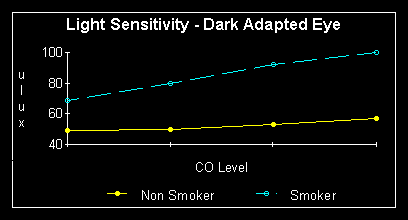
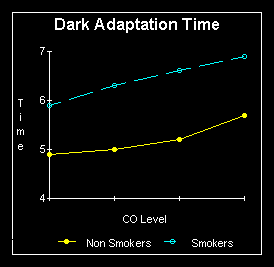
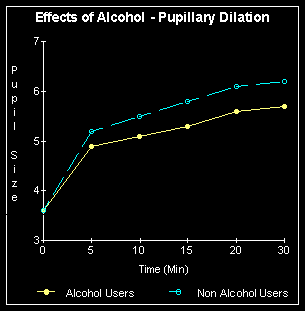 source
source
When I was living in the woods I took up a personal challenge to refrain from using any artificial light source for one year. Much like being in the woods itself or going without matches/lighter, it became enjoyable and I soon transformed into a 'dark snob'. This term of my creation refers to anyone who looks down on all those still enslaved to their portable light sources at night. The poor souls were limited to a circle of awareness of a few feet, blinded to all other happenings not in the direct line of shine. Their luminous globules would bob and bounce through the forest, along trails, announcing to all their coming, rate of travel, direction, and sometimes numbers. I enjoyed meeting them going the other way in complete darkness which without fail silenced their group as they never conceived of navigating without a light! It was easy to step off a trail and sit to let them pass, but staying on the trail was more fun. Campfires make fore easy stalking fun, no one can see anything except what's right around the fire. People leaving the fire can't see what's in the dark and think it's actually dark out. Same goes for lighted buildings.
Now it is incorrect to turn into any kind of 'snob', dark, light, fire, GPS, primitive, or otherwise. It robs one of knowledge and humility and it is a natural human trait and must be monitored. The point here is that flashlights are overrated, and I went for years without owning one including many seasons of instruction work with outdoor students who just figured I didn't want to turn mine on (they weren't allowed to have any of course). And I lived in the woods, that is, ate, slept, taveled, tracked, hunted and survived. Now I love my headlamp, and I regularly use lights as tools. They are tools, nothing more. One can learn to use touch, memory, and senses as well as patience and move in darkness without any electrical systems - it's amazing how much light there is when we let our bodies adapt. This must be studied and understood before moving on to light amplification devices which are dependent on a variety of factors; money, batteries, correct functioning, and training/practice. By the way, never, ever shine your light into a friend's face to see who they are or whatever. Lights off ground and into faces is rude, unprofessional
ELECTRONIC LIGHT AMPLIFICATION
Night Vision devices, NVD's, Night vision goggles, NVG's, and so on, work on principles of light amplification. That is, they take existing light provided by moonlight, stars, or distant artificial sources, and bring up the values by as many as 65,000 times! Basic active devices accelerate photons received into a phospher screen. This 'photoacceleration' results in small pools of light on the screen which are then visible to the human eye. This explains the dull green tint of NV systems prevalent in video games and movies. Take a look at the mountain man at the top of this page - he is depicted very much like he would be in 1/2 moon light through a well focused NVD at short range. Devices are categorized as generation I, II, III, and IV which reflect quality of imaging, complexity of construction and of course, COST. Gen I devices can be found for a little as $100 while high level current production units can exceed $10,000. All Gen I, II, and III of the modern day are equipped with an IR, or infrared beam light. This handy tool shoots out a light which is invisible to the human eye but which lights up an area when viewed through the NVD. This allows the nature observer to 'see' in total darkness; indoors, under dense canopy, or on a clouded or moonless night. When looking directly at the IR beam it appears as a dull red cherry. For this reason one should avoid direct beams onto alert targets. Always remember that anyone else with NV eq can see your light like a giant flashlight as well.
My favorite owl stalks have been with an IR equipped NVM (monocular). I could see eyes reflecting IR light from over 150 yards easily, in total darkness. Excitedly I'd call my friend over and we'd stalk in, at times getting within arms length of resting woodland creatures. One night an owl pooped right in front of us before turning his head and taking off. What a reward for patient, quiet movement!
What are active and passive systems?
Passive systems are basically extra large lenses that take in more light. Like ninjas of fuedal Japan who made hand tunnels increase retinal size and adjust rods and cones, thereby raising perceived light gain (visible light) at night, these simply use natural systems to see better in low light. Active systems include those mentioned above as well as infrared (FLIR), and thermal systems which 'read' heat sources.
For the purpose of this skill set at the USCRC, I'm going to use a fantastic Gen I device manufactured by ATN, American Technologies Nightvision. I picked up the 5x magnification monocular off of Ebay for $100, and it works great. People rag Gen I devices but as you'll see it's a blast to observe nocturnal animals with and can be a safety device as well. The Nightowl by ATN comes standard with a strong IR projector which allows observation in total darkness. I always recommend using redundant battery type power sources in all electronic gear so batteries can easily be switched, and for ease of charging with portable solar units in the field. Thinking about getting something with a battery that costs $19.99 and is called a ZN345-h5n? Stick with AA and you'll be happier down the road, I promise.
Basic Care
Treat the device as you would any high end optic. Avoid temperature extremes, keep it enclosed in a protective container, and make sure you have appropriate cloth for cleaning available such as a microfiber glass/optics material. Even if waterproof avoid subjecting your NVD to water or submersion as is possible and treat it kindly. Realize this piece of gear is classified as 'sensitive' and therefore needs extra security from theft and loss.
ALWAYS keep the protective lens cover on until the unit is being used and is in darkness. Many modern NVD's have compensators or compression systems to avoid burnout or light damage but not most. Harsh or direct light can fry your system or at least put undo strain on it.
To make batteries last the longest use the NV device only when necessary and immediately turn it off, likewise with the IR projector. I generally do short scans of an area before moving through using my fully dark adjusted eye to see without the device. So hear this, when using a monocular use only one eye for bolts of time so the other is able to see in the dark naturally. If wearing goggles, be aware that both eyes are losing light sensitivity.
Correct Use
Practice! Practice with your device. When you pull it out the box you will likely find the first few seconds disappointing if it's your first time with any NVD. It's not quite like the video game you played, and isn't as clear as the latest spy tech movie you may have seen. However, in a short time you will find that the focus adjustments will clear up the scene, and your eye itself will learn to see through the NVD. Interpretation of shadows is a learned skill and quickly adjusting for distance takes a little time as well. So, let's go outside and take a look. My digital camera shot decent pictures straight through the eyepiece. You will see, Gen I devices are not so bad.
Below you will find a view of my barn in lightly clouded, full moonlight. Rollover the image with your mouse to see how ATN's Gen I NVM improves the situation. Take special note of 'shadow zones', or areas not visible without assistance.
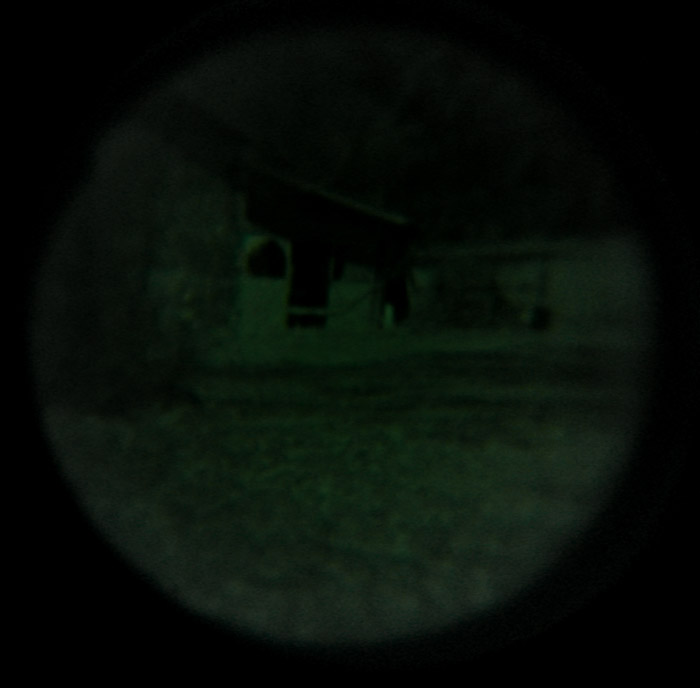
Here's another rollover image. This points out the importance of focusing correctly. Move your mouse over the image to see the difference between a focused and an unfocused image through a Gen I light amplifier.
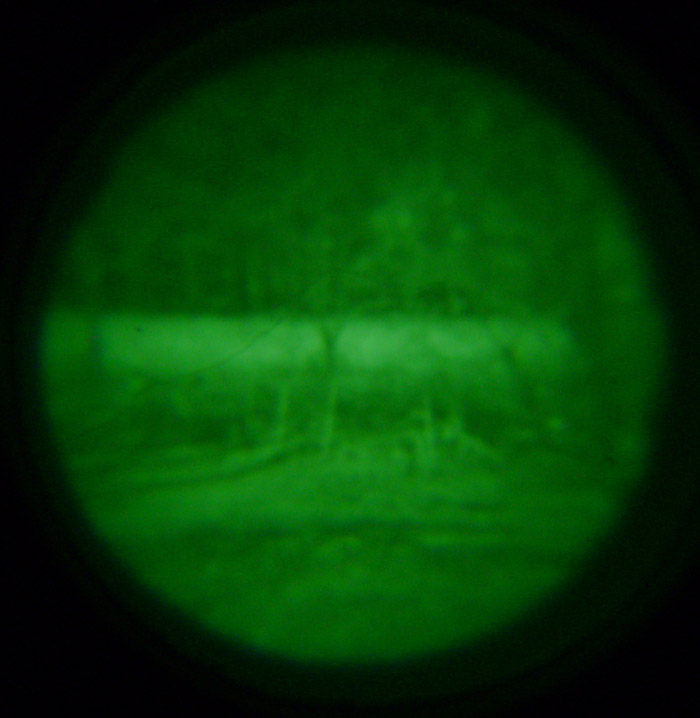
In the following example take note of the Shadow Zones. On a moonlit night it is possible for a dark adapted eye to see very well. However, reaching into dark unlit areas is almost impossible especially at range. These are the most likely areas for animals to take refuge in anyway. The picture below is observing a darkened forest transition zone at a distance of 60 yards. Anything hiding under the forest canopy would be discernable even without full focus.
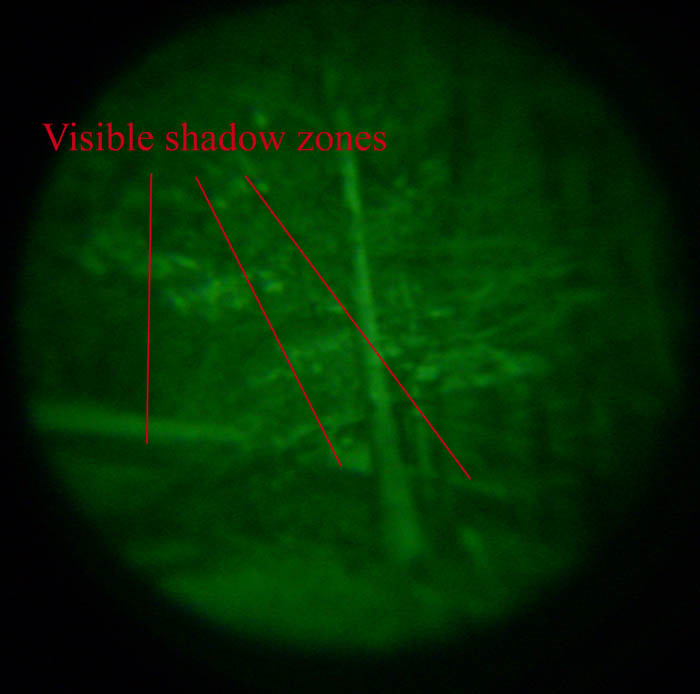
Now we move into the shadow recognition training. This requires a little more practice. Like tracking, we have to know what a natural ground is supposed to look like before we see what has disturbed it. Without cheating by going further down the page, can you see what the following scan of my back yard had to offer?
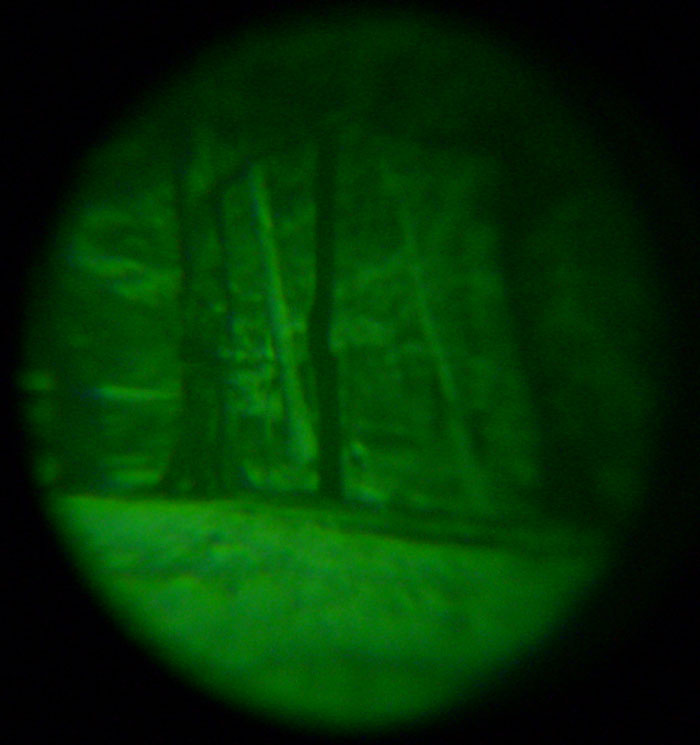
It's right there! Do you see it? Look carefully again if you did not. Remember, a good outdoorsperson will use natural shapes to their advantage, even in a passive way, as a standard operating procedure.
Give up? Well, the second tree from the left has a clearly visible person with outstretched arm holding a walking stick! And I thought the dogs were just barking at the moon. Haven't so many unsuspecting dog owners, eh?
Another moment of quiet observation yielded spectacular results!
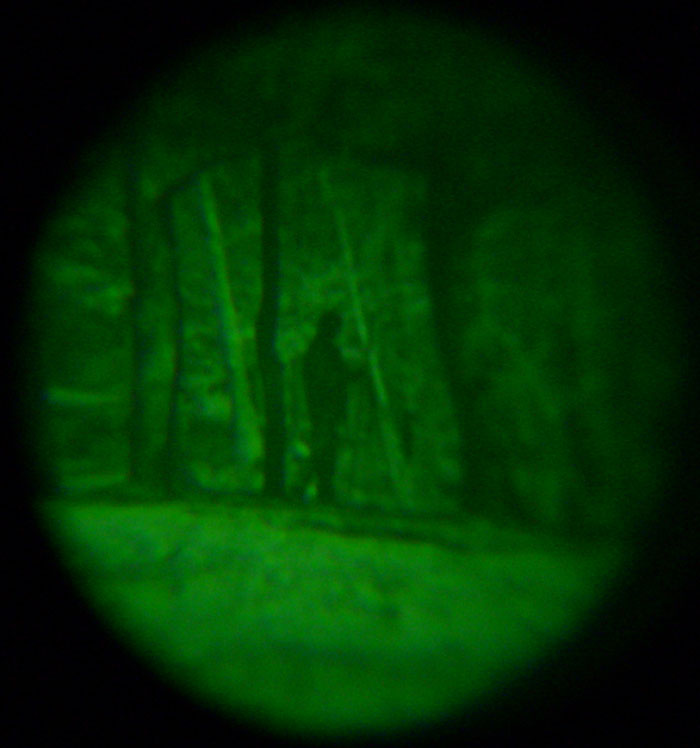
I continued to watch quietly as the moonlighter glided silently across a field and into the distant forest. Range to target: 50 yards.
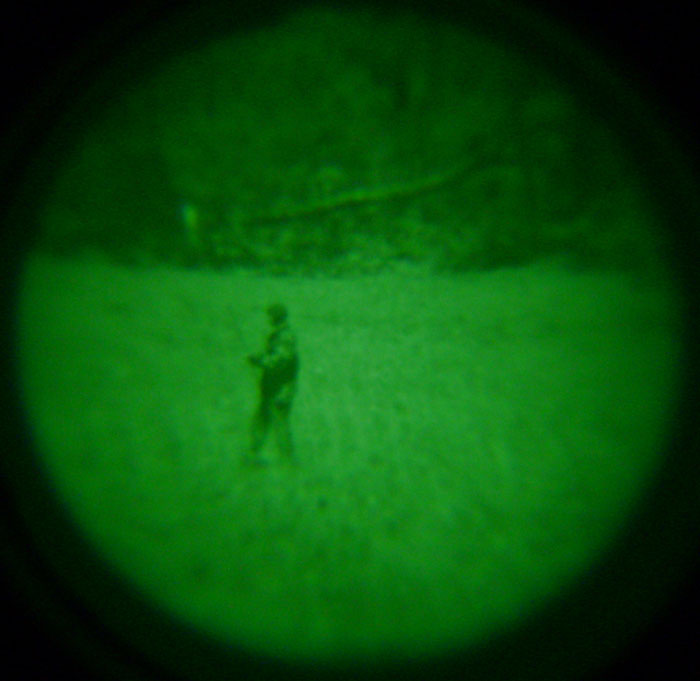
And our final example is a great shot across a large area prone to visits from fox, coyote, and the occasional bear. I guess tonight human visitors as well, eh? Note the clarity of even distant objects, and also note the optical distortion around the edges of the view field. This is a rollover image, take your mouse over the photo to see another view with a feature ID.
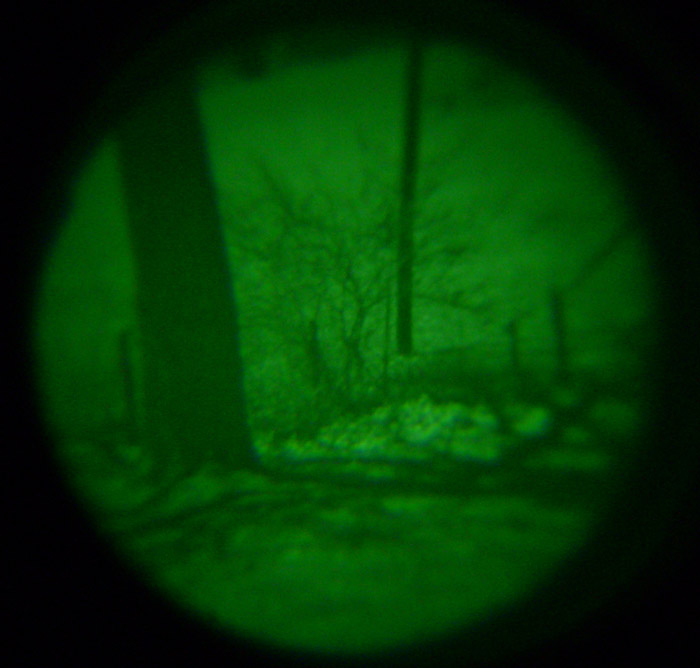
These images were taken with a stock Sony digital camera through an ATN Gen I NV monocular without any adapting devices. Actual images are even clearer through eyepiece. Total eq cost was $300 including camera! I have seen many deer, owls, bear, fox, coyote, snakes, and people through casual, unsuspecting, observation with this NVD. It is well worth it to invest in such gear if you plan to use it. Remember, get something with commonly available battery sizes, preferably one that can be recharged through simple solar systems. This avoids the most obvious problem with tech gear for the long range mountaineer.
Glossary of Helpful Terms
PASSIVE - Refers to large aperture scopes, binoculars, and other observation devices which allow more light to reach the viewers eye. There is an ideal size which equals what the human is able to receive, modern military observation apertures are based on this ideal size for passive light transmission. No electronics are needed, therefore no batteries or electro signatures to be detected while in use.
ACTIVE - An active system is one that uses some power source to filter received energy, amplify received energy, or otherwise alter or decode material and put it in a form which is observable to the human eye.
GAIN - The number of times a night vision device amplifies light input. Usually measured as tube or system gain, it commonly has values in the tens of thousands. US military image tubes typically operate between 12,000 and 65,000.
LINE PAIRS - a.k.a. line pairs per millimeter (lp/mm). This is a measurement of resolution. The more line pairs, the better the resolution. The best tubes are currently at 64+ line pairs. Generation 3 units will typically have 51 to 64 line pairs and are a factor to consider in price.
PHOTOSENSITIVITY - a.k.a. photocathode sensitivity. It is the ability of the photocathode to produce an electrical response when subjected to lightwaves (photons). The higher the value, the better the ability to produce a visible image under darker conditions.
RESOLUTION - The ability of an image intensifier or night vision system to distinguish between objects closer together, measure in line pairs per millimeter (lp/mm). There is a difference between system resolution and image intensifier resolution. System resolution can be affected by altering the objective or eyepiece optics, or by adding magnification lenses. Image intensifier resolution remains constant. System resolution is very important in determining the quality of a system.
SIGNAL-TO-NOISE RATIO - The low light resolution of the image tube. The higher the signal-to-noise ratio, the better the ability of the tube to display objects with good contrast under low light conditions. It is the single best indicator of an image intensifier's performance.
Questions:
1.) What can you do to boost your light sensitivity and ability to see at night without any devices?
2.) What do we never do with flashlights?
3.) Explain the difference in Passive and Active NV systems and give an example of each.
4.) What chemical is responsible for human nightvision?
5.) What does it take to get used to a NVD?
6.) Define the following terms from memory; Gain, Line Pairs, Photosensitivity, Signal to Noise Ratio.
Application:
1.) Correctly clean any NV device.
2.) Employ it using sound procedures of care and safety while developing skills of shadow recognition.
3.) Play field games with a partner using the NVD to find each other in a variety of environments.
4.) Locate and observe 5 animals on different occasions under varying degrees of moon or ambient light.
Back to Free Skill Set List
visit www.lotswild.com to sign up for a Land of the Sky Wilderness School course this year